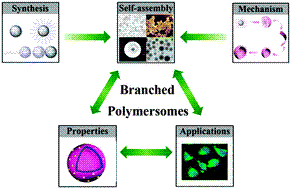- Hyperbranched polymer vesicles: from self-assembly, characterization, mechanisms, and properties to applications
- 来源:周永丰教授个人网站 2015-03-09

Vesicles, including lipid vesicles, surfactant vesicles, as well as polymer vesicles, have been extensively investigated over the past fifty years. Among them, polymer vesicles have attracted more and more attention because of their low permeability, superior stability and toughness, in addition to the numerous possibilities for tailoring physical, chemical and biological properties. Polymer vesicles are generally fabricated through the self-assembly of amphiphilic polymers with a linear architecture. Recently, as representative polymers with a highly branched three-dimensional architecture, hyperbranched polymers have also exhibited great potential for preparing vesicles. The resultant hyperbranched polymer vesicles, defined as branched-polymersomes (BPs), have shown unique properties, such as giant and easily tuned vesicle sizes, facile functionalization, a special formation mechanism, and appealing solution behaviours. In this tutorial review, ten years of advances in BPs have been summarized since their first discovery in the year 2004, including the syntheses of vesicle-forming hyperbranched polymers, self-assembly methods, self-assembly mechanisms, as well as the special properties. In addition, the cytomimetic, biomedical and other initiatory applications of BPs are also included.
- [来源:中国聚合物网]
- 了解更多请进入: 周永丰教授个人网站